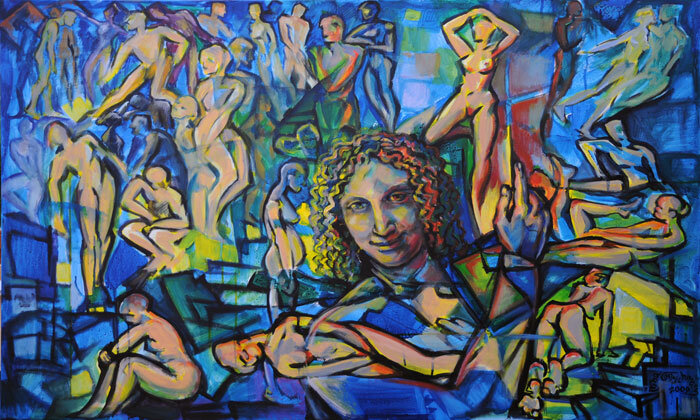John the Baptist

In her painting John the Baptist, Irina Gerschmann arranges nude people in different situations and attitudes in a cubist-ornamental colour swatch in cool blue shades. Male and female acts dynamically line up on several levels of imagery and present a wide range of human existences and sensitivities – a pregnant woman, a mother with her child, a remembered, floating love couple, moments Self-forgotten car eroticism, lascivious exhibitionism, introverted despair, dynamic interaction. The skin tone of the black-coloured figures ranges from bluish-cool hinting to fresh yellowish accentuation to warm reddish reflections, which underline the sensuality of the respective figures and with the cool overall mood of the Painting. With her own love for expressive corporeality, Gerschmann sketches a modern Dramatis personae in which the viewer can find himself again.
In this tableau naked body, which also reminds of the tradition of the World Court Pictures, advertised Gerschmann Leonardo da Vinci’s well-known interpretation of St. John, who with ironically-distant smile in mysterious gesture the sky Has. Gerschmann accentuates this gesture by flaming colour accents in red and yellow, which effect the aforementioned reddish reflections on John’s surrounding nudes and on Johannes ‘ hair and face. This fire is reminiscent of the pagan custom of the St. John’s Fire, which has been around since the 12th In the solstice of the century, the summer season, which precedes the birth feast of the saint, is danced and jumped. In fact, individual figures encircled John the Baptist and thus the hinted solstice fire in a kind of dynamic circle, which in turn reminds the sinners of lust in Dante’s Inferno, who are doomed to all eternity by hurricanes to Be.
The Association of John the Baptist with the subject of the Last Judgement is by no means an innovation – the preachers with the lamb is a tradiertes attribute in world Court pictures. Gerschmanns choice of the predominantly blue color refers to John’s admonition to repentance through water baptism. The lascivious eroticism of the depicted file is not only an appropriate allusion to the coming final court, but also reminds of the historically transmitted events that led to John’s arrest and beheading: John had the adultery of King Herod Publicly denounced.
Gerschmanns adaptation of this subject is also interesting with regard to its own religion: the Gospel belongs to the world of the Hellenistic, but is strongly influenced by the Jewish milieu. Rather, the tradition of water baptism, which is inextricably linked to John, is still element to the ritual washings of the Jews.
were not the title and Leonardo’s dominant figure of the Baptist, the painting could be regarded as a tasteful, dynamic composition of different acts. However, in this combination, which is unexpected for today’s time, it stimulates thought. Gerschmanns paintings impressively depict the Messianic baptism with “Holy Spirit and Fire”, but at the same time parodies the tradition of the holy Representation and the Last Judgement. Without warning, Gerschmann, with this painting, draws attention to the narrowness of the line between Bliss and sin in today’s society – with a puzzling smile.
October 2009
Anthony Baldwin
Ma Comparative Literature/Comparative Literature
Otto-Friedrich-Universität Bamberg/University of South Carolina
